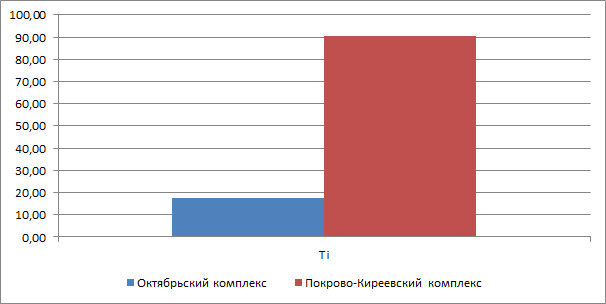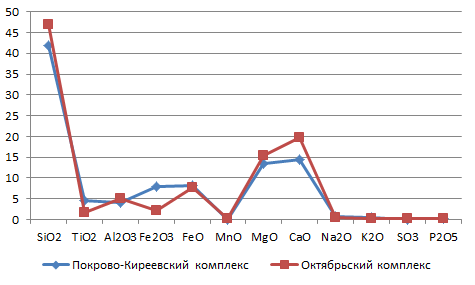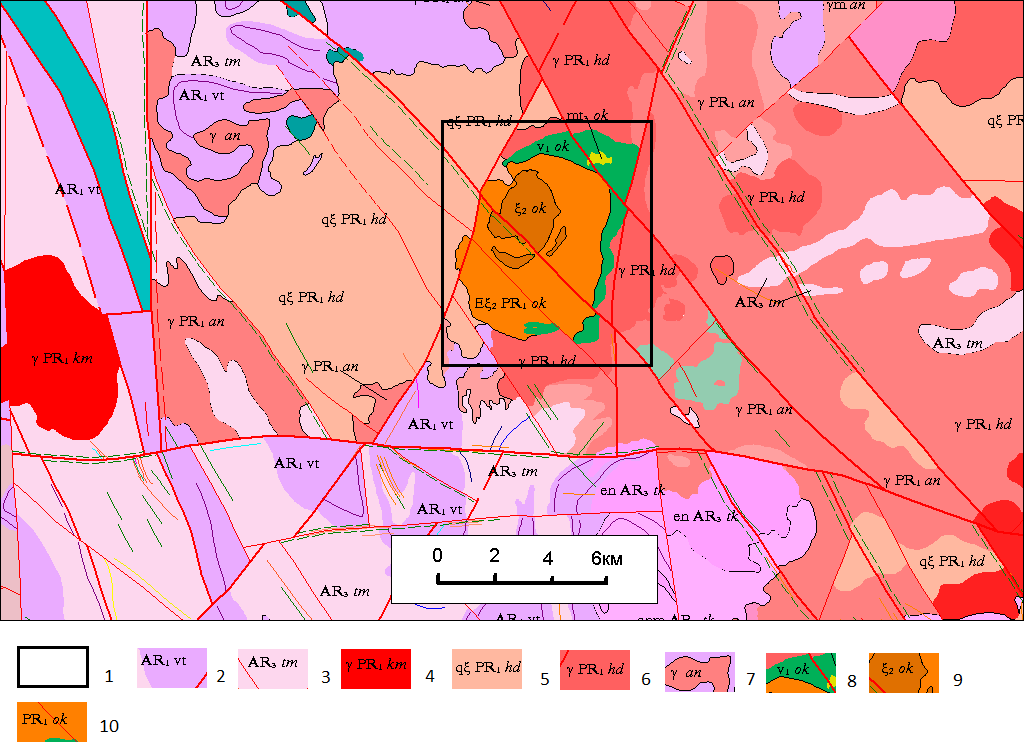Abstract
Сontent
- 1. General description of the work
- 1.1 Relevance of the topic
- 1.2. Connection of work with the scientific programs, plans, topics
- 1.3. Purpose of the work
- 1.4. Objectives of research
- 1.5. Object and subject of study
- 1.6. Research methods: geochemical, mineralogical, and mathematical statistics by using computer programs.
- 1.7. Scientific novelty.
- 1.8. The practical significance.
- 1.9. Personal contribution to the work's author.
- 1.10 Approbation results.
- 2. Theoretical bases of formation of basites and ultrabasites of Octyabrsky and Pokrovo-Kireyevsky complexes, their formational.
- 3. Analysis of geological study basites and ultrabasites of Octyabrsky and Pokrovo-Kireyevsky complexes.
- 4. The degree of similarity and differences of basic and ultrabasic rocks of Octyabrsky and Pokrovo-Kireyevsky massifs.
- 5.Conclusions
- References
1. General description of the work
1.1 Relevance of the topic
The theme of work is chosen in connection with the relevance expanding the mineral base of the country. In Ukraine, we observed a shortage of certain mineral resources which are imported from other countries. It concerns of refractory materials, fluxes for metallurgical production of certain ferrous and nonferrous metals. On the other hand, there are a lot of questions on the geology of basites and ultrabasites of the two massifs which insufficiently studied and require detailed investigation. Especially the important question is studying of formational rocks complexes, the prospects of their metal content and the factors that influence the ore content.
1.2. Connection of work with the scientific programs, plans, topics
The topic of master’s work matches the priority direction of scientific research and scientific and technological developments for the until 2015 “Technology of identification and evaluation of mineral resources and their rational ecologically safe mining” (an application to the Resolution of the cabinet of Ministers from 7.09.11 № 942). The topic of work chosen on the request of Azov comprehensive geological expedition.
1.3. Purpose of the work
Investigate the differences in geological and structural position, mineralogical, petrographic and geochemical the rock composition, geochemical specialization and formational of basites and ultrabasites. Determine their potential ore content.
1.4. Objectives of research
- Consider the theoretical bases formation of basites and ultrabasites and their formational distribution.
- To analyze the geological study of basites and ultrabasites of Oktyabrsky and Pokrovo- Kireyevsky complexes.
- Determine the extent of the similarities and differences of basic and ultrabasic rocks of the two complexes.
- Determine the formational and potential ore potential of basic and ultrabasic rocks the two complexes.
1.5. Object and subject of study
Object - basic and ultrabasic rocks of Octyabrsky and Pokrovo-Kireyevsky complexes.
Subject of study - structural-tectonic position, features of mineralogical and petrographic composition and potential ore content of basic and ultrabasic rocks of the two complexes.
1.6. Research method
Geochemical, mineralogical, and mathematical statistics by using computer programs.
1.7. Scientific novelty
Were established the differences in the structural-tectonic position of the massifs. Were established geochemical role of ultrabasic and basic rocks in the formation of the Octyabrsky massif of rare-metal mineralization - geochemical barrier. Were established geochemical differences of basic and ultrabasic rocks of the studied massifs. For Pokrovo-Kireevsky massif fitted the prospect of basic and ultrabasic rocks on the titanium mineralization. Were established a connection with the rocks of grorudites Pokrovo-Kireyevsky array as derivatives of basaltic magma. Were established a structure-tectonic, mineralogical, petrographic differences of grorudites of Vasilievka district (basin. Kalmius) and river basin Gruzkv Elanchik.
1.8. The practical significance
Expanding perspectives ore content of district in connection with the alleged at a depth massifs of basic and ultrabasic rocks.
1.9. Personal contribution to the work's author
Was performed the analysis of previous research, was estimated of structural-tectonic position of the two massifs, was performed data processing geochemical researches of basic and ultrabasic rocks, was processed structural-geological, mineralogical and petrographic studies of grorudites. For the further mineralogical and petrographic studies were made microsections of rocks.
1.10 Approbation results
By results of work is planned: the publication of one article to deliver, a report at the conference with the publication the report theses.
2. Theoretical bases of formation of basites and ultrabasites of Octyabrsky and Pokrovo-Kireyevsky complexes, their formational
Ultrabasites and basites, which are the main component of the ophiolite association and platform of basite-ultrabasite complexes are common in various structures of the oceans and continents and have an age from the early Precambrian to the Phanerozoic. With the magmatic rocks are genetically related the deposits of chromite, copper-nickel ores, platinum, titanium, phosphorus and other important minerals. With the ultrabasic and basic volcanics of the Early Precambrian iron ore deposits are associated. Geosynclinals and platform basite-ultrabasite complexes are widely developed in the Ukrainian Shield.
Octyabrsky complex compose of the subalkaline basic and ultrabasic rocks, alkaline and nepheline syenite. Rocks of Octyabrsky complex are forming the two massifs: Octyabrsky and Sherbakovsky [7]. On the basis of data of various studies (S.G Kryvdik and V.I Tkachuk, etc.) ultrabasic and basic rocks of the Octyabrsky complex were classified as complex magmatic complex gabbro-syenite with consecutive petrogenetic series of differentiates - subalkalint pyroxenite and gabbro - syenite – pulaskites (nepheline syenite) - foyaites - mariupolites - agpaitic nepheline - syenite (aegirine foyaites) and phonolites [4].
Pokrovo-Kireyevsky complex represents the most recent phase of the Devonian magmatism. N.V. Buturlinov and later A.N. Donskoy attributed this complex to alkaline magmatism platform mode [7]. The most complete Devonian magmatism has been studied V.I. Gonshakovoy, N.V. Buturlinovym, I.D. Tsarovskim. These researchers all the complexes including the effusive and vein formation, identified as alkalicultrabasic - alkalicbasaltoid formation. In the formation was allocated four subformations:
- Ultrabasic - pyroxenite, pyroxenite ore, peridotites (the most ancient);
- Alkalicultrabasic kimberlite;
- Alkalicbasaltoid - limburgity, avgitity, pseudoleucitic basaltoids;
- Alkaline - malinity, phonolites, nepheline syenite.
Pokrovo-Kireyevsky complex - the only complex in the Ukrainian Shield alkaline rocks of after Precambrian age. N.V. Buturlinov conjectured - probably alkaline metasomatism originated in the introduction of later alkaline magmas in the previously formed ultramafic rocks. Time gap the formation of these rocks is about 100 million years, so is likely to the ultramafic and alkaline rocks are formed independently of the evolving deep centers. Therefore the ultramafic and genetic associated gabbros are grouped in the separate from alkaline rocks magmatic complex [1]. This point of view the author of this work uses as a fundamental.
3. Analysis of geological study basites and ultrabasites of Octyabrsky and Pokrovo-Kireyevsky complexes.
Octyabrsky massif was studied primarily from the point of view of ore-bearing alkaline rocks. It was established that the mineralization in alkaline rocks of the Octyabrsky complex have the metasomatic character, the basic-ultrabasic rocks are the enclosing for the ore-bearing rocks, and also served as a geochemical barrier for rare metal ore-bearing solutions, and the most ancient ultrabasic and basic rocks contain accessory apatite, sphene and titanomagnetite (up to 15 %), rarely pyrite, pyrrhotite, chalcopyrite, pentlandite. In comparison with Clark for ultrabasic and basic rocks (by Vinogradov A.P.). They are specialized in (0,3-0,5%), Co (0,1%), Cr, Ti (0,6-1%), Pt (до 0,6 г/т), Nb, TR, Ce [2],[3].
Basic and ultrabasic rocks - the earliest in the massif. The most widespread is a gabbro rarely found pyroxenite, peridotite and olivinites, S.G Kryvdik and V.I Tkachuk [5] оreported that by various researchers (Aynberg L.F., 1933; Eliseev N.A, Kushnev V.G, Vinogradov, D.P, 1965) were installed gradual transitions between the basic and ultrabasic rocks. Among the gabbro were identified - the usual melanocratic and going over to the pyroxenite, and olivine and olivine-free varieties, with the predominance of olivine [5].
In the rocks of the complex marked a rhythmic layering of the ultrabasic and basic rocks expressed in the change from the contact to the center of the massif peridotite-pyroxenite gabbro, as well as the presence of layers in peridotite and pyroxenite olivinites hidden layering of the of the massif is reflected in the directional change in the composition of plagioclase and clinopyroxene. [5].
Pokrovo-Kireyevsky complex. The structure of the Pokrovo-Kireyevsky complex includes Pokrovo-Kireyevsky massif which folded of ultrabasites (olivinites, peridotite, olivine and feldspathic pyroxenite, pyroxenite ore) gabbro pyroxenite and gabbro. The structure of the array a concentrically zoned, the periphery is composed of pyroxenite includes with pyroxenite ore interbeds, and the central part is folded gabbro. According to Shcherbakov I.B. [7] gabbros formed from the residual melt which infiltrates into the bundle mass of pyroxenite. Pokrovo-Kireyevsky massif has appeared in the modern erosive cut due to bloc movements along the faults. Contact the massif with the enclosing rocks predominantly tectonic, due to the lack information about the lateral contacts of the intrusion authentic allocation of array to any of the known types is difficult. N.V. Buturlinov considering the concentrically zoned location of rocks in the massif and its shape in plan view, suggested that the intrusion has the shape of the subjacent intrusive and goes to a considerable depth [1].
Some content of impurity elements in the following pyroxenite Cr-320, Ni – 260, Zn- 130, Cu-140, Zr-170, Tr-310, Rb – 18, Be – 10, Sr – 70, Ta – 28 g / m [7].
Shcherbakov I.B. noted that the rocks of Pokrovo-Kireyevsky massif characterized by a low content of SiO2, Al2O3 and high Ti2.
4. The degree of similarity and differences of basic and ultrabasic rocks of Octyabrsky and Pokrovo-Kireyevsky massifs.
By the results of researches were established following the similarities of the two massifs:
- On the content of silica and alkali gabbro of Octyabrsky and Pokrovo-Kireyevsky massifs on the diagram Makdonolda-Katsuri (in coordinates (Na2O+K2O)-SiO2) are located in the alkaline basalts [5].
- Layering of the central part of massifs ultrabasic and basic rocks.
The main distinctive features:
- Age of forming. Ultrabasites and basites of Octyabrsky massif belongs to the Precambrian formations, while the ultrabasic and basic rocks Pokrovo-Kireyevsky complex belongs to the Hercynian cycle ( D1-D2).
- Ultrabasic and basic rocks of Octyabrsky massif genetically related with alkaline rocks, which forming with them a consistent transition from a purely alkaline ultrabasic petrographic differences [5], while the ultramafic and gabbro of Pokrovo-Kireyevsky complex subjected alkaline metasomatism in about 100 million years after their formation.
- The contact ultrabasic rocks of Pokrovo-Kireyevsky complex in most of the tectonic which indicates about picked up gabbro-pyroxenite-peridotite massif with the considerable depths [1]. For Octyabrsky massif role of the tectonic factor in the structure manifested weaker.
- Were established the significant differences in the content of impurity elements in ultrabasic and basic rocks of Pokrovo-Kireyevsky and Octyabrsky complexes (Табл. 1). As the table shows all the ultrabasic rocks of Pokrovo-Kireyevsky complex have higher contents of titanium, copper and lead, the higher vanadium content observed in pyroxenite and gabbro.
- In terms of ore specialization of ultrabasic rock both complexes they are radically different from each other.
Rocks of Pokrovo-Kireyevsky complex are perspective on the titanium mineralization, while the ultrabasic-basic rocks of Octyabrsky complex act as a geochemical
barrier for rare metal mineralization. The microelement composition of the rocks Pokrovo-Kireyevsky complex confirms their specialization in titanium ore
(excess clarke contents observed in more than 90 times (Табл. 2). For better visual comparison Clarke concentrations of two massifs are shows diagrams (1,2,3)
Observed a significant an excess of Ti, V, Cu in the pyroxenite of Pokrovo Kireyevsky complex compared to Octyabrsky pyroxenite complex (see fig. 1,2,3)
There are significant differences between the two petrochemical massifs.

Figure 1. Clark’s concentration values V, Sc, Cu, Zn

Figure 2. Clark’s concentration values Ni, Co, Cr

Figure 3. Clark’s concentration values Ti
In the pyroxenite of Pokrovo-Kireyevsky complex marked the reduced compared with the Octyabrsky pyroxenite complex content of SiO2 and Al2O3, at the same time noticeably the explicit excess in pyroxenite Pokrovo Kireyevsky complex content of TiO2 and Fe2O3 (Table 3). The high contents of these oxides indirectly confirm the specialization in titanium rocks of Pokrovo-Kireyevsky massif.

Figure 4. Graphical representation of the chemical composition of pyroxenite two massifs
- The different structural position of the two arrays in Azov megablock Ukrainian shield. Pokrovo-Kireyevsky complex is located at the junction zone Donbass and Azov is timed to the crossing of the faults in the crystalline basement, intrusive bodies of ultrabasic-basic rock are hidden under the Mesozoic sediments. Intrusive bodies of the complex "are displaced" along the South Donbass fault (Fig. 5). Octyabrsky complex is located directly in the Azov megablock of Ukrainian shield its formation most likely related to the platform magmatism. Ultrabasic-basic rocks frame the alkaline rocks of the complex from the north-east (Fig. 6)

Figure 5. The position of the Pokrovo-Kireyevsky massif on of geological scheme of Priazovsky megablock Ukrainian Shield
1 – Contour of Pokrovo- Kireyevsky massif; 2 – metamorphic formations of Neoarchaean age; 3 – granodiorite amphibole and biotite-amphibole; 4 – anadol granite complex of the early proterozoic; 5 – hlebodarskoe granite complex of the early proterozoic; 6 – anadol granite complex of the early proterozoic; 7 – ultrabasic and basic rocks Pokrovo-Kireyevski complex; 8 – lower carboniferous sedimentary rocks (suite A);
9 – оlower carboniferous sedimentary rocks (suite В); 10 – lower carboniferous sedimentary rocks (suite С); 11 – alkaline rocks Pokrovo-Kireyevski complex.
Figure 6. The position of the Octyabrsky complex on of geologic scheme of Priazovsky megablock Ukrainian Shield
1 – Contour of Octyabrsky complex; 2 – early archean metamorphic rocks of age; 3 – metamorphic formations neoarchaean age; 4 – kamennomogilskogo granite complex of the early proterozoic; 5 – hlebodarskoe quartz syenite complex of the early proterozoic; 6 – hlebodarskoe granite complex of the early proterozoic; 7 – anadol granite complex of the early proterozoic; 8 – basic and ultrabasic rocks Octyabrsky complex; 9 – October syenite complex; 10 – alkaline rocks Octyabrsky complex;5. Conclusions
By the results of investigations were established formational ultrabasic-basic rocks of the two complexes, the differences in the structural position of the two complexes in the Azov megablock - Pokrovo-Kireyevsky complex is located at the junction zone of Donbass and Azov is timed to the crossing of the faults in the crystalline basement, Octyabrsky complex is located directly in the Priazovsky megablock Ukrainian shield its formation most likely related to the platform magmatism.
Were established a different age, formation ultrabasic rocks of the two arrays - ultrabasites and basites of Octyabrsky massif relate to Precambrian formations, while the ultrabasic and basic rocks Pokrovo-Kireyevski complex belongs to the Hercynian cycle ( D1-D2).
Were established the connection with the rocks grorudites Pokrovo-Kireyevsky massif as derivatives basaltic magma.
Were established that the basic-ultrabasic rocks of the complex are the geochemical barrier for rare metal mineralization of alkaline rocks. Ultrabasic and basic rocks Pokrovo-Kireyevsky complex promising for the detection of complex titanium mineralization.
Were established the differences in the structural position of the two complexes, a different age, formation of ultramafic rocks of the two massifs. Revealed significant differences in the content of impurity elements in ultrabasic and basic rocks, as in the work were marked differences in the petrochemical composition of basites and ultrabasites of the two massifs.
References
- Бутурлинов Н.В. Геолого-петрографическая характеристика щелочно-ультраосновного – щелочно-базальтоидного комплекса зоны сочленения Донбасса с Приазовской частью Украинского щита / Н.В. Бутурлинов, В.И. Гоньшакова, В.Ф. Юрченко // Базит-гипербазитовый магматизм и минерагения юга Восточно-Европейской платформы. – М: Недра, 1973. – С. 186-228.
- Волкова Т.П. Проблемы генезиса и рудоносности Октябрьского массива щелочных пород / Т.П. Волкова // Сборник научных трудов НГА, 2000, № 4,с.9-10.
- Волкова Т.П. Критерии продуктивности редкометальных месторождений и рудопроявлений Октябрьского массива / Т.П. Волкова // Наукові праці ДонДТУ,серія гірничо-геол., 2001, вип.36, с.63-69.
- Заварицкий А.Н. Изверженные горные породы. / А.Н. Заварицкий // М.; Изд-во АН СССР. – 1955. – с. 479.
- Кривдик С. Г. Щелочной магматизм приазовья / С.Г.Кривдик, Н. В. Безсмолова, А. В Дубина. // Наукові праці УкрНДМІ НАН України, № 5 (частина II), 2009, с 158-165
- Кривдик С. Г. Петрология щелочных пород Украинского щита./ С.Г, Кривдик В. И. Ткачук // Киев.; Наук. думка. – 1990. – 406 с.
- Щербаков И.Б. Петрология Украинского щита./ И.Б. Щербаков – Львов .; ЗУКЦ – 2005. – с. 364
- The different structural position of the two arrays in Azov megablock Ukrainian shield. Pokrovo-Kireyevsky complex is located at the junction zone Donbass and Azov is timed to the crossing of the faults in the crystalline basement, intrusive bodies of ultrabasic-basic rock are hidden under the Mesozoic sediments. Intrusive bodies of the complex "are displaced" along the South Donbass fault (Fig. 5). Octyabrsky complex is located directly in the Azov megablock of Ukrainian shield its formation most likely related to the platform magmatism. Ultrabasic-basic rocks frame the alkaline rocks of the complex from the north-east (Fig. 6)
